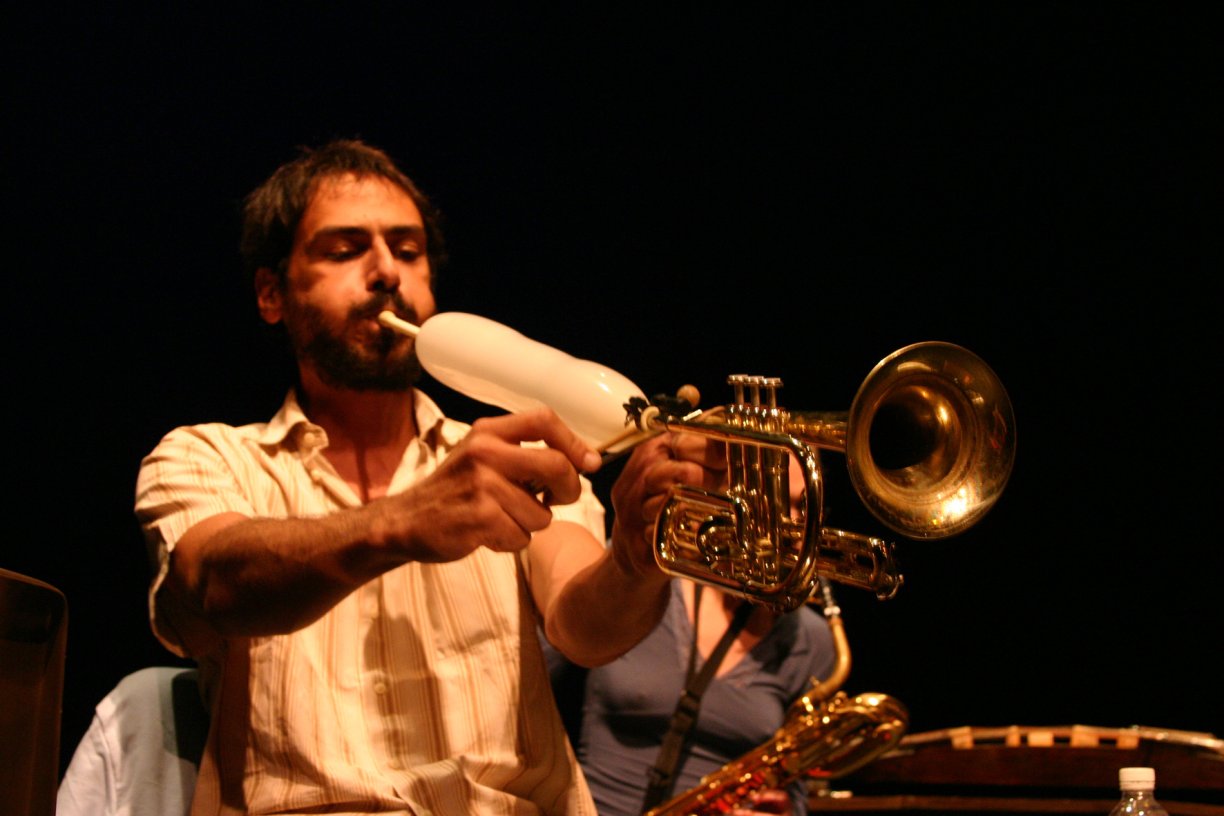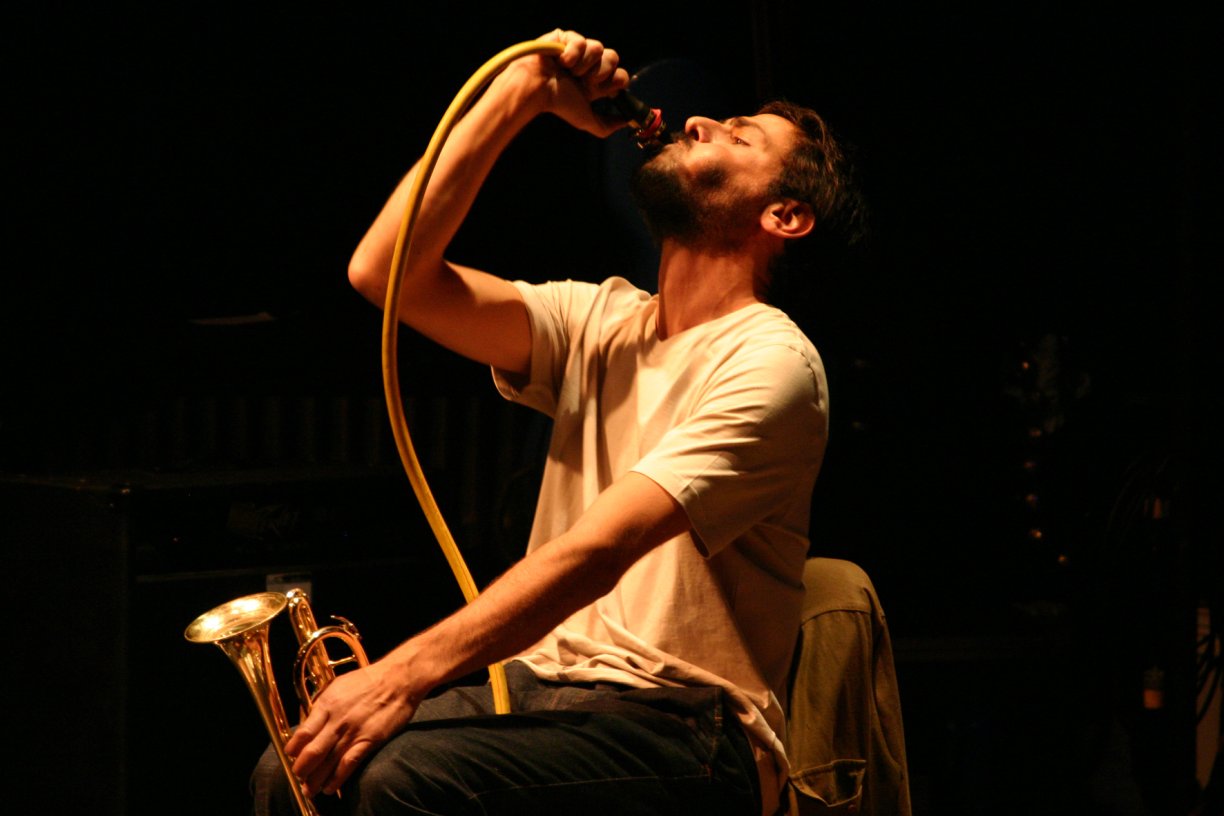I met Mazen at Penn Station about 7 years ago. I helped him navigate the chaotic “Chinatown bus” system and we had our first conversation on our way to play a series of concerts with saxophonist Jack Wright in Philadelphia that same night. I had heard a lot about Kerbaj, but was unprepared for what I heard. The series of preparations he put his trumpet through that evening was truly revelatory to the point of not knowing truly what I thought of his music. It took me the whole weekend of concerts to come to grips with Mazen’s language, culminating in our first duo concert, a musical moment I remember to this day. This fall, Mazen and I will meet up again, 8 years older and with languages changed and solidified to make more memories. Issue Project Room asked me to introduce you to him, something I’m happy to do through this series of questions about his work as a musician and artist, answered via email in the summer of 2012.
-Nate Wooley
Nate Wooley: I know you as a player of trumpet and woodwinds. Which came first? What got you started playing trumpet and why is it your main instrument now?
Mazen Kerbaj: Actually, I started with the trumpet, then shifted to woodwinds, then played both for a while and ended up with trumpet only. The choice of trumpet is quite anecdotal in the first place: it was my friend and musical partner, guitarist Sharif Sehnaoui who proposed to give me an old trumpet that was sitting in his place and that was never played. I was around 18 years old back then. I accepted it as a joke first, not knowing that I would really play it one day and become a musician (for the record, I had never played any instrument before).
When I shifted to woodwinds, it was mostly because I felt very limited with the trumpet. Ironically, I came back to trumpet when I realized that it had endless possibilities (way more than saxophones, as far as I am concerned). I also managed to transpose most of my woodwinds playing to the trumpet, via the mouthpiece and various other extended techniques.
NW: We've spoken in the past about our mutual admiration for Evan Parker. I feel like we both are drawn to work that is experimental but rigorous in the way that it builds a language. Can you talk about how his music influenced you in the direction of what you're doing now?
MK: Well, I can see many facets in the influence of Evan's music on mine. The most obvious is probably the heavy use of circular breathing and the work on simultaneous sounds, but there are many other aspects to this influence: the interest in electronics and electro acoustic setups for improvisation (especially the ones involving real time processing), the search for unusual acoustics for recording purposes, the focus on solo works, etc.
Also, like you said, there is the rigor part. I have always been attracted to experimentation in arts (from music to movies, comic books, visual arts, etc.), but have always been very critical about using experimentation only for its own sake. It is one thing to "create something new", but it’s another to make this “something new” relevant, rigorous, and interesting in itself, beyond the way it was done or its novelty.
NW: You’re equally known for your visual art. How do you think about the sound and visual work you make in relation to each other?
MK: I have difficulties situating my practice(s) myself. I somehow do not find any relation between my visual works (comic books, paintings and video works) and my music, but I’ve heard many times friends – and critics – talking about an evident relation.
As far as I’m concerned, the visual and sound worlds involve very different practices, at least from the point of view of the artist: in the visual arts you are in a total solitary setup and you conduct your research in a "confined space". Your relation to the receiver (the viewer) is quasi non-existent. You only relate to the work, and only in the moment it is being created. You produce your work, and once it is finished, it is dead for you. You start working on something else just as it begins to exist (or it comes to life) for the viewer… precisely at this death moment – or after death, at the moment it is published or exhibited.
In music, it is a very different story, especially if we are talking about performing live – and even though I might sound "retro", playing live is the only "reality" of music as far as I’m concerned. "When music is over, it is gone in the air. You can never capture it again" said Eric Dolphy on his last recording session in Holland (and Joe McPhee went a step further by using this sentence as titles for recorded pieces). You create your "piece" together with the receiver(s) in real time (and space). Somehow, the spectators are witnessing the birth and the death of the work. And at the end, it is dead for everybody.
On another level – the viewer's one – I tend to think that music is much more aggressive and hard to accept than any other art/medium, because it is the only one that penetrates you, while you usually have to go out to meet the work of art. I can give you an example: in visual arts, you have to make the effort to "see" the work. You look at it and then interpret it. Meanwhile, music fills the room and penetrates you without any effort on your part. Actually, you would have to put forth effort to escape the invasion by putting your fingers in your ears). Music fills time and space like no other medium, and this makes it more AND less powerful at the same time.
Another thing that is both an advantage and a disadvantage about music is its tendency to be exclusively abstract, with some rare exceptions like musique concrete and other in situ experiences (and here I can’t help but talk about my own experience with recording with the Israeli bombs falling on Beirut, or Steve Lacy's work with recordings from the Vietnam war). However, in drawings you can choose to be abstract or concrete, figurative, narrative, etc.
Music is by essence a purely emotional medium. For example, when Beethoven names a piece "l'hymne a la joie", you can hear it and feel that it is very sad. It’s because of these kinds of paradoxes, that I tend to think that music is both a superior AND an inferior means of expression.
NW: It seems like only a die-hard handful of American musicians are well-acquainted with Al Maslakh and the Beirut scene. Can you talk a little about who is involved, how you came together and what you do?
MK: After a couple of years working in a very small circle (just three musicians), we started a festival for improv and free jazz, called Irtijal (improvisation in Arabic) to start a real "scene" in Lebanon where these practices never existed. The rare small adventures in music there were a couple of contemporary music concerts before the civil war (1975-1990). The festival brought many international musicians to the Lebanese audience, but also gave opportunities for the Lebanese musicians to meet with these musicians in ad hoc groups, and to propose a platform for the practice of "unconventional" music in Lebanon (actually in all the Middle East and the Arab world). Today, after 12 years of existence, the festival has become a reference in the region, and programs music (and cross-disciplinary performances) in genres as different as avant-rock, contemporary music, free jazz, free improv, dance, live visuals, etc.
After a few years of the festival, it became clear that we needed a label to publish what was happening in Lebanon. I started Al Maslakh (the slaughterhouse) in 2004 to "publish the unpublishable on the Lebanese artistic scene". We needed to publish our music (and other's music recorded in Lebanon) to make it available to the Lebanese audience on one hand, and to be able to present our work to the world on the other. It is indeed very difficult to make yourself known (and to get invited to international festivals) if you do not have recorded material. The label became as successful as the festival and soon became a reference for improv and free jazz from the region. Two years ago, after many cross projects with the punk and avant-rock (God, how I hate these sub-categories) scene in lebanon, we launched a new sub-label called "Johnny Kafta's Kids Menu", dedicated to electronic and electric experimentation. Like its older brother, it publishes only projects by Lebanese musicians or projects recorded in Lebanon like the latest mike cooper solo CD.
NW: I know most of the Al Maslakh players are now spending some time in different parts of the world, but you still have the festival every year. How have things changed, how have they stayed the same and has that affected the way you think and hear and play?
MK: Many of us tour regularly now and spend indeed part of the year on the road, but we are mostly all still based in Beirut. Even Sharif Sehnaoui, who lived for ten years in Paris, returned to Lebanon definitely in 2008. The scene here is still small, but steadier and always growing. We have at least 10 regular improvisers plus many musicians evolving around the festival (Irtijal).


